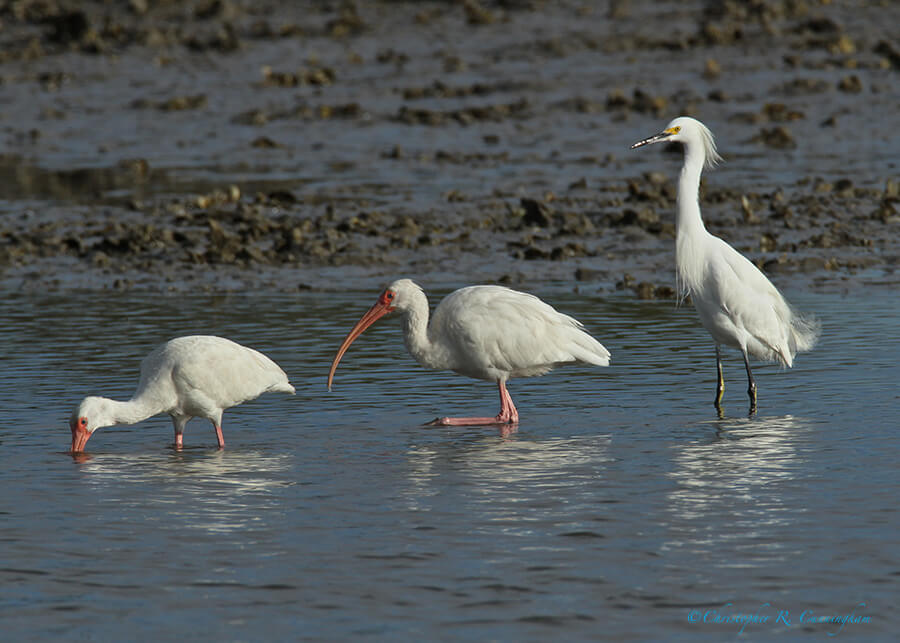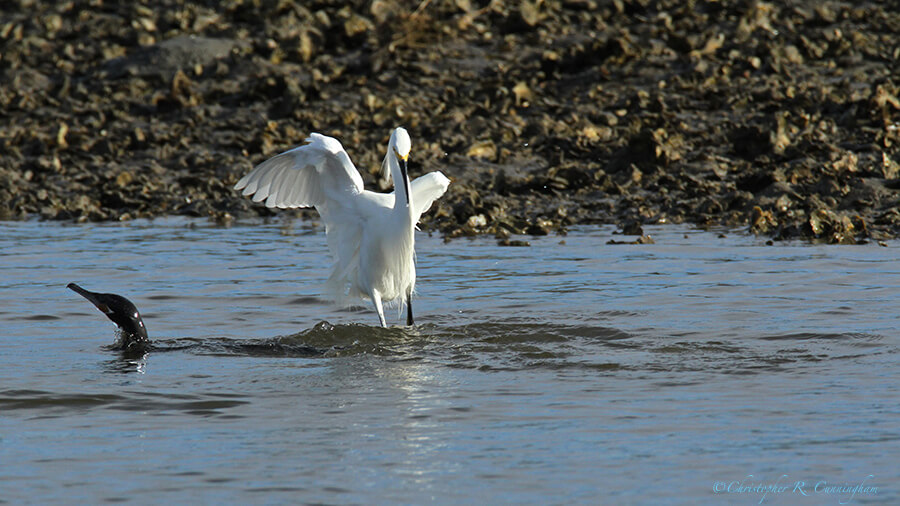
Salt marshes, tidal channels, and lagoons along Frenchtown Road, Bolivar Peninsula, Texas often make for exceptional birding. On our last visit to Frenchtown Road (8-10 AM, 1/17/15), I observed several interesting avian fishing techniques at low tide among the exposed oyster patch reefs. Although a number of bird species (including Short-billed Dowitchers, Killdeer, Spotted Sandpipers, and American Avocets) were taking advantage of the low water level, a Snowy Egret was being especially opportunistic. I made observations referenced in this post on the north shore of the western extremity of the east-west channel. j
Among waders, Snowy Egrets may have the widest repertoire of hunting and fishing techniques, and I have written about several of them, including blowing bubbles to attract prey and shadowing Pied-billed Grebes from the shore as the latter spooked up prey, among others. At Frenchtown Road, this Snowy Egret shadowed a group of White Ibises as they hunted the shallows for infaunal invertebrates along the margins of the exposed oyster reefs at low tide. Presumably the ibises flushed prey, thus saving the egret the energy of exercising its most famous hunting technique, that of waving its bright yellow feet.
More interesting was when a Double-crested Cormorant went zooming back and forth, through the channels between reefs. As the cormorant swam past, the Snowy Egret launched into a frenetic dance and struck at prey in the cormorant’s wake, not unlike the dancing between bouts of underwing fishing exhibited by Reddish Egrets and Tri-colored Herons. This type of commensal behavior has been documented previously in the scientific literature (Bennett and Smithson, 2001; Emlen and Ambrose, 1970) and on-line for interaction of Snowy Egrets with such species as White Ibises, Double-crested Cormorants, Blue-winged Teal, and Red-breasted Mergansers.
These observations suggest several questions: Why do Snowy Egrets Exhibit such a wide range of hunting behaviors relative to other waders? How many new strategies remain to be be discovered? Given the widespread distribution of Snowy Egrets across the Americas, do Snowy Egrets interact with only a handful of other species, or rather do they simply look for prey-flushing disturbances, irrespective of the species/source? Clearly, there are many more observations and interpretations to be made.

You can observe a lot by watching.—Yogi Berra
References:
Bennett, J., and Smithson, W. S. 2001. Feeding associations between Snowy Egrets and Red-breasted Mergansers. Waterbirds 24 (1): 125-128.
Emlen, S. T., and Ambrose III, H. W. 1970. Feeding interactions of snowy egrets and red-breasted mergansers. Auk 87: 164-5.
©2015 Christopher R. Cunningham. All rights reserved. No text or images may be duplicated or distributed without permission.